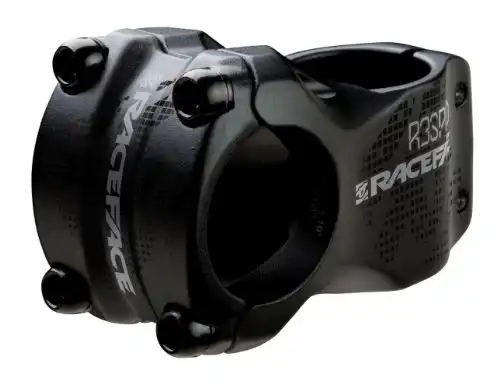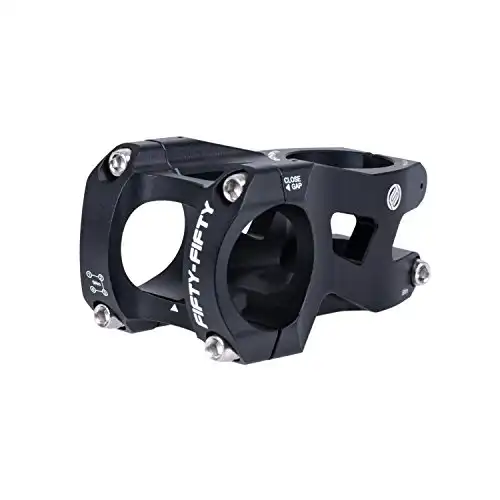Walking through the bike shop the other day it amazed me how many choices there are, particularly when it comes to selecting the right mountain bike stem length. Is there a general stem that works well for everyone, or do I need to pick one based on my preferred terrain and riding style?
The best average stem length for modern mountain bikes falls between 50 mm and 80 mm. Shorter stems allow for quicker handling and are preferred by many downhill riders, whereas cross-country riders enjoy longer stems for their superior climbing performance.
While stem length is probably the most critical factor in selecting a new stem, there are also other factors that you should consider such as stem rise, clamp diameter, material, and design.
All of these choices should be considered when optimizing for your preferred riding style!
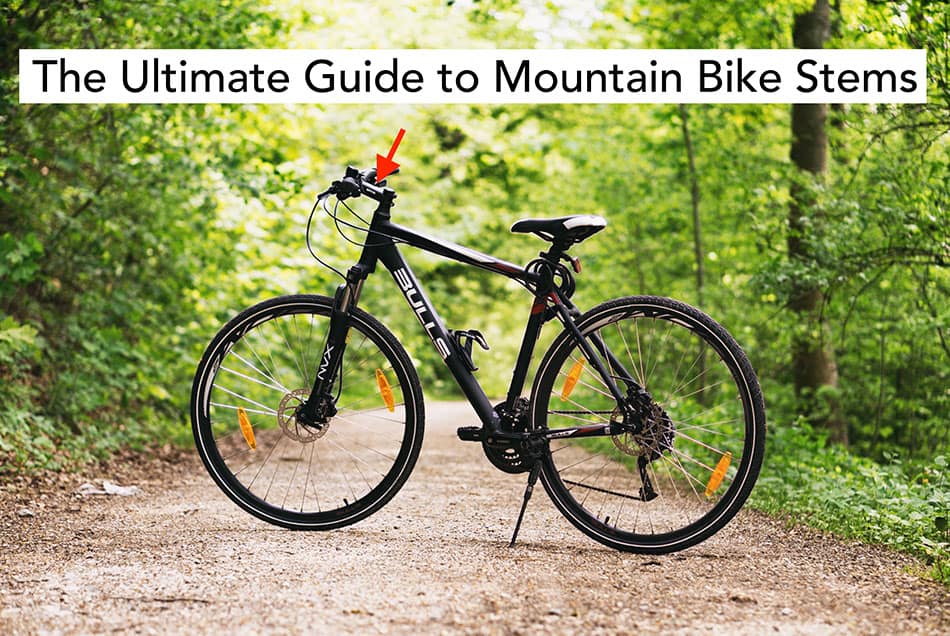
How to pick the right mountain bike stem
Mountain bike stem criteria #1 – Stem length
Stem length is one of the most critical factors controlling how your bike handles!
Shorter stems allow a rider to more quickly turn the wheel, enhancing the bike’s handling characteristics and feel. This is ideal for downhill, trail, and enduro riders as it allows them to have more responsive handling during descents.
A shorter stem length also shifts your weight slightly backward and helps prevent you from dumping over the handlebars.
Many downhillers enjoy stems in the 40 mm – 50 mm range, whereas trail and enduro riders go a little bit longer with 50 mm – 80 mm stems.
Longer stems pull your body forward and shift more weight onto the front wheel. This places you in a better pedaling position and makes for more efficient seated climbing.
For this reason, cross-country riders trend towards longer stems in the 80 mm – 120 mm range.
Mountain bike stem criteria #2 – Stem rise
Rise refers to the angle that the stem makes relative to the fork steerer tube. For short stems, the angle is less of a concern because it has so little distance to travel upwards (rise) or downwards (drop).
For longer stems, it’s more of a factor because of the additional distance it has to shift the handlebars up or down.
Much like stem length, the amount of rise is usually correlated to the style of riding.
- Downhill riders usually prefer that their handlebars are not raised or elevated at all. This correlates to a 0-degree rise.
- Trail and enduro riders fall between 0 and 6 degrees of rise, leaning more towards the longer end of that range.
- Cross-country riders usually prefer a drop (lowering) anywhere between 0 and 30 degrees.
Mountain bike stem criteria #3 – Clamp diameter
While the trends seem to change every few years, there really are just two choices when it comes down to picking a clamp diameter for modern mountain bikes.
35 mm clamps seem to be the most common width that modern bikes come with nowadays, but 31.5 mm clamps are very popular as well.
The key benefit to a wider clamp is that it provides greater stiffness and durability. In some cases that extra width comes with added weight as well, so it’s worth considering the potential tradeoff.
If you have an older bike you may notice that it’s clamp is 25.4 mm, but these are pretty rare to find these days. Keep in mind that if you do choose to change clamp diameters that you’ll also need a new set of handlebars as well.
Mountain bike stem criteria #4 – Clamp material
The vast majority of stems are made of aluminum. However, you may come across cheaper bikes that have stems made of steel.
High-end stems can be made of carbon fiber, making them both lighter and more expensive. Unless you fell in love with the carbon fiber look and have extra cash to spend, it’s usually not worth the investment.
It may be worthwhile for competitive racers looking to save weight!
If you want a fancier looking stem but without the cost of carbon fiber, you may want to check out CNC machined aluminum stems.
Mountain bike stem criteria #5 – Clamp design
For the front bar clamp portion of the stem, they can come in 2-bolt and 4-bolt options. Four bolts is more common these days because they’re stronger and stiffer.
The rear clamp holds the stem on the fork steerer. Most use a 2-bolt design, but some downhill varieties use a single large rear bolt whereas cross-country variations use a wedge design with the bolt on the front.
The most common concern to watch out for with clamp design is that the rear clamp bolt heads don’t stick too far out. During a crash, they’ll act like battering rams for smashing your knees into and will not be a pleasant experience.
Handlebar considerations with stem length
When selecting the stem length you need to take into account any sweep of the handlebars.
Let’s say for example that you pair a 40 mm stem with a set of 780 mm wide handlebars that have 8 degrees of sweep. If that sweep is angled directly backward then it takes your stem down to an effective length of 30 mm.
Depending on how you angle the handlebars, this effective stem length shortening could be less.
On that note, once you have selected a stem length you may also want to take a look at your handlebar width. Many riders with shorter stems find that they enjoy wider handlebars. Conversely – the shorter the stem, the narrower the handlebar.
How do you measure the length of a mountain bike stem?
If you’re considering replacing your current mountain bike stem then it’s important to know the length of your current stem.
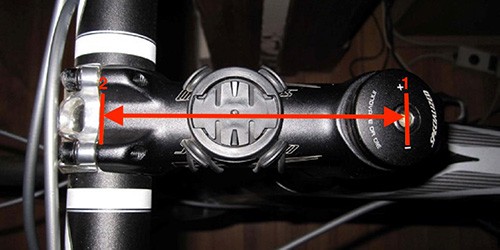
- Find the top of the steering head that holds the steering column. This is called the headset.
- Measure from the center of the headset to the center of your handlebars.
- If your ruler does not have millimeters listed, you can take a measurement in inches and multiply it by 2.54.
Let’s say that you’ve got an 80 mm stem, but spend most of your time trail riding. Going for a shorter stem, perhaps something in the 50 – 60mm range could be a good choice.
If you live for bombing down hills, it’s worth checking out a 40 mm stem.
Can a mountain bike stem be too short?
Stem length truly comes down to a matter of personal preference. While bike length certainly plays a factor in just how long or short your stem can comfortably be for you, it’s still a matter of personal preference.
However, the general thought is that 25 mm of effective stem the shortest anyone should go.
While you can find ultra-short stems on the market, you may find that they shift your weight too far backward on the bike. If you find yourself noticing that the steering feels funny or a little off, then you probably need to make adjustments.
When the bike is perfectly situated, its handling should feel effortless and smooth for you to control.
If you’re looking for a new stem, below are a few that I’d recommend considering.
Designed for riders wanting big hit performance at All Mountain weights. The Respond stem is engineered to offer an optimal combination of strength, stiffness, and weight at an attractive price point.
Designed to bridge the needs of AM and FR riders, light enough for AM, tough enough for FR.
How do you find the angle of a stem?
Stem angle is calculated by measuring the drop (or elevation) of the handlebars from parallel. It’s very helpful to use an angle tool to help judge the stem angle because the differences are so small.
The image below depicts a rise or positive stem angle. Most cross-country bikes are set up to have a slight drop below horizontal (negative rise).
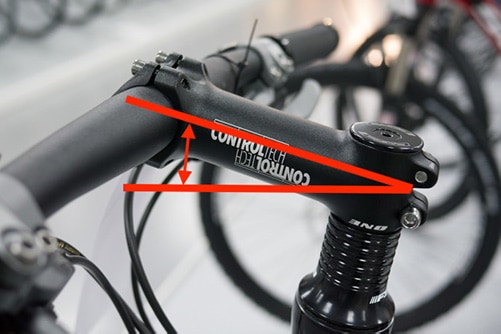
Related Questions
- What diameter are mountain bike bars? Modern mountain bike handlebars can be found in 31.8 mm and 35 mm widths. Older standards used a width of 25.4 mm bars but are uncommon today.
- How wide are mountain bike handlebars? Mountain bike handlebars range from 680 mm – 800 mm wide. Shorter widths (680 mm – 740 mm) are preferred by cross-country riders, while downhill riders enjoy longer ones (760 mm – 800 mm). Trail and enduro riders fall into the middle of those two ranges. For more information about handlebars, make sure to look at my dedicated article here.
- What is the stem of a bike? The stem is the component that connects the handlebars to the steering tube of the fork.
If you found this article helpful, then you will probably enjoy my full guide where I explain all mountain bike frame measurements.

